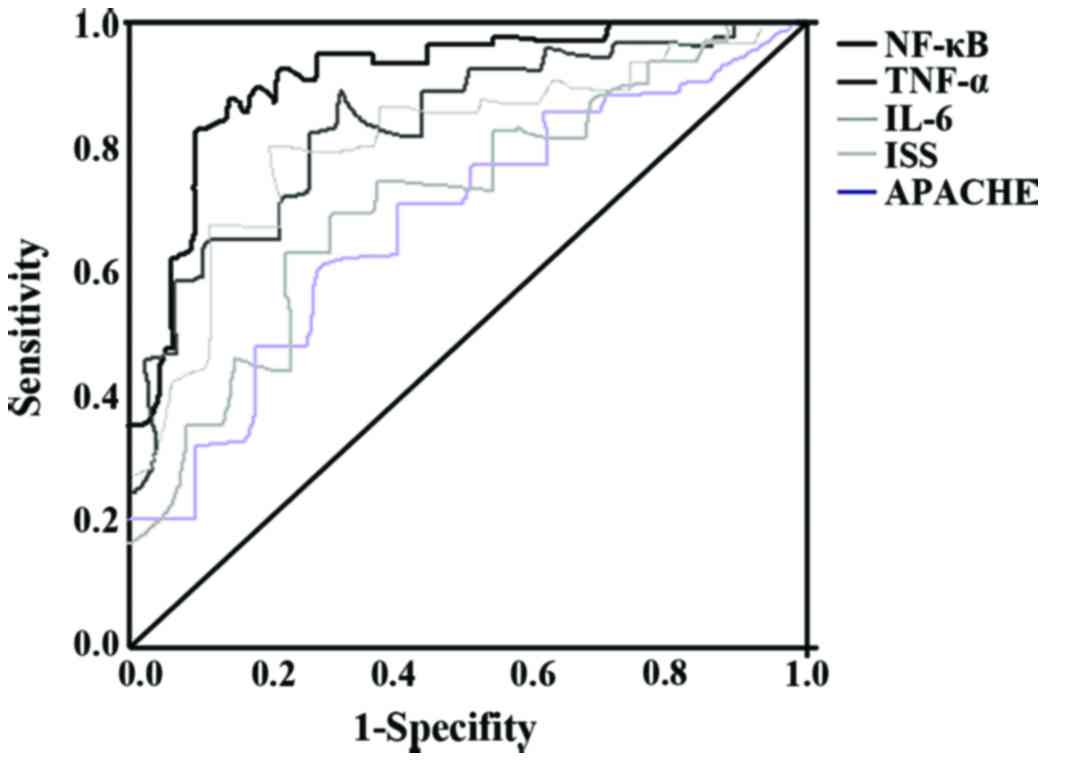|
1
|
Fremont RD, Koyama T, Calfee CS, Wu W,
Dossett LA, Bossert FR, Mitchell D, Wickersham N, Bernard GR,
Matthay MA, et al: Acute lung injury in patients with traumatic
injuries: Utility of a panel of biomarkers for diagnosis and
pathogenesis. J Trauma. 68:1121–1127. 2010. View Article : Google Scholar : PubMed/NCBI
|
|
2
|
Davenport R and Brohi K: Fibrinogen
depletion in trauma: Early, easy to estimate and central to
trauma-induced coagulopathy. Crit Care. 17:1902013. View Article : Google Scholar : PubMed/NCBI
|
|
3
|
Frink M, van Griensven M, Kobbe P, Brin T,
Zeckey C, Vaske B, Krettek C and Hildebrand F: IL-6 predicts organ
dysfunction and mortality in patients with multiple injuries. Scand
J Trauma Resusc Emerg Med. 17:492009. View Article : Google Scholar : PubMed/NCBI
|
|
4
|
Matsuda N, Hattori Y, Takahashi Y,
Nishihira J, Jesmin S, Kobayashi M and Gando S: Therapeutic effect
of in vivo transfection of transcription factor decoy to NF-kappaB
on septic lung in mice. Am J Physiol Lung Cell Mol Physiol.
287:L1248–L1255. 2004. View Article : Google Scholar : PubMed/NCBI
|
|
5
|
Moraes LA, Piqueras L and Bishop-Bailey D:
Peroxisome proliferator-activated receptors and inflammation.
Pharmacol Ther. 110:371–385. 2006. View Article : Google Scholar : PubMed/NCBI
|
|
6
|
Cuzzocrea S, Pisano B, Dugo L, Ianaro A,
Maffia P, Patel NS, Di Paola R, Ialenti A, Genovese T, Chatterjee
PK, et al: Rosiglitazone, a ligand of the peroxisome
proliferator-activated receptor-γ, reduces acute inflammation. Eur
J Pharmacol. 483:79–93. 2004. View Article : Google Scholar : PubMed/NCBI
|
|
7
|
Marshall JC, Cook DJ, Christou NV, Bernard
GR, Sprung CL and Sibbald WJ: Multiple organ dysfunction score: A
reliable descriptor of a complex clinical outcome. Crit Care Med.
23:1638–1652. 1995. View Article : Google Scholar : PubMed/NCBI
|
|
8
|
Damiani P and Burini G: Fluorometric
determination of nitrite. Talanta. 33:649–652. 1986. View Article : Google Scholar : PubMed/NCBI
|
|
9
|
Dougnac A, Riquelme A, Calvo M, Andresen
M, Magedzo A, Eugenin E, Marshall G and Gutiérrez M: Study of
cytokines kinetics in severe sepsis and its relationship with
mortality and score of organic dysfunction. Rev Med Chil.
129:347–358. 2001.(In Spanish). PubMed/NCBI
|
|
10
|
Stegmaier J, Kirchhoff C, Kanz KG, Mayer
V, Landes J, Euler E, Mutschler W and Biberthaler P: Analysis of
NF-kappaB nuclear translocation in PMN-neutrophils of major trauma
patients in the early post-traumatic period: A pilot study. World J
Surg. 30:2142–2151. 2006. View Article : Google Scholar : PubMed/NCBI
|
|
11
|
Zhao E, Wang L and Wen Q: Fasudil
hydrochloride differentiates bone marrow mesenchymal stem cells
into neurons via notch signaling. Neural Regen Res. 5:814–819.
2010.
|
|
12
|
Pacary E, Legros H, Valable S, Duchatelle
P, Lecocq M, Petit E, Nicole O and Bernaudin M: Synergistic effects
of CoCl(2) and ROCK inhibition on mesenchymal stem cell
differentiation into neuron-like cells. J Cell Sci. 119:2667–2678.
2006. View Article : Google Scholar : PubMed/NCBI
|
|
13
|
Pacary E, Petit E and Bernaudin M:
Concomitant inhibition of prolyl hydroxylases and ROCK initiates
differentiation of mesenchymal stem cells and PC12 towards the
neuronal lineage. Biochem Biophys Res Commun. 377:400–406. 2008.
View Article : Google Scholar : PubMed/NCBI
|
|
14
|
Collison LW, Workman CJ, Kuo TT, Boyd K,
Wang Y, Vignali KM, Cross R, Sehy D, Blumberg RS and Vignali DA:
The inhibitory cytokine IL-35 contributes to regulatory T-cell
function. Nature. 450:566–569. 2007. View Article : Google Scholar : PubMed/NCBI
|
|
15
|
Neunaber C, Zeckey C, Andruszkow H, Frink
M, Mommsen P, Krettek C and Hildebrand F: Immunomodulation in
polytrauma and polymicrobial sepsis - where do we stand? Recent Pat
Inflamm Allergy Drug Discov. 5:17–25. 2011. View Article : Google Scholar : PubMed/NCBI
|
|
16
|
Marti L, Cervera C, Filella X, Marin JL,
Almela M and Moreno A: Cytokine-release patterns in elderly
patients with systemic inflammatory response syndrome. Gerontology.
53:239–244. 2007. View Article : Google Scholar : PubMed/NCBI
|
|
17
|
Li J, Li NP, Gu YF, Yang X, Lu XB, Cong
JN, Ling Y, Tang JA, Yuan XY and Wang H: Dynamic activity of
NF-kappaB in multiple trauma patients and protective effects of
ulinastain. Chin J Traumatol. 14:354–358. 2011.PubMed/NCBI
|
|
18
|
Yadav K, Zehtabchi S, Nemes PC, Miller AC,
Azher M, Durkin H and Sinert R: Early immunologic responses to
trauma in the emergency department patients with major injuries.
Resuscitation. 80:83–88. 2009. View Article : Google Scholar : PubMed/NCBI
|
|
19
|
Shih HC, Huang MS and Lee CH:
Polymorphonuclear cell priming associated with NF-κB activation in
patients with severe injury is partially dependent on macrophage
migration inhibitory factor. J Am Coll Surg. 211:791–797. 2010.
View Article : Google Scholar : PubMed/NCBI
|
|
20
|
Li R, Zijlstra JG, Kamps JA, van Meurs M
and Molema G: Abrupt reflow enhances cytokine-induced
proinflammatory activation of endothelial cells during simulated
shock and resuscitation. Shock. 42:356–364. 2014. View Article : Google Scholar : PubMed/NCBI
|
















